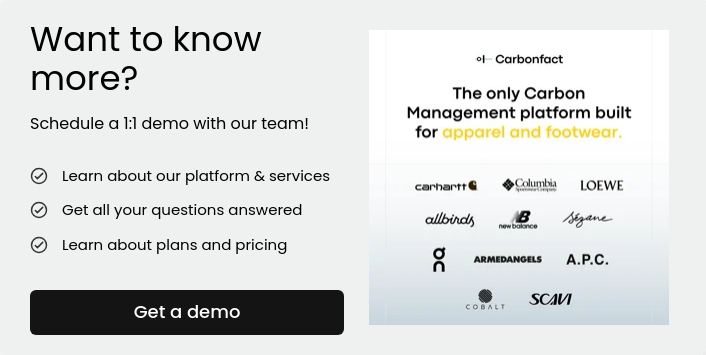Materials widely used in the apparel and footwear industry, like nylon, have reliable and comprehensive carbon footprint data, as they have been extensively studied. While Carbonfact has a robust materials library, many brands use unique materials or new innovations that require custom solutions. That’s where our science team steps in, creating bespoke emission factors to accurately reflect the carbon impact of each brand’s specific materials and processes.
.jpg?width=2400&height=1260&name=Dec%20Newsletter%20-%20Materials%20gif%201%20(3).jpg)
What is an emission factor?
An emission factor quantifies the greenhouse gases emitted from specific activities or materials, such as energy use in manufacturing or the production of raw materials. To calculate the environmental footprint of a material or product, we need to quantify how much of a greenhouse gas is released into the atmosphere by an activity or process (e.g. dyeing, spinning, shipping).
We do this with the help of activity-based emission factors, a coefficient that allows us to convert activity data into GHG emissions. It is the average emission rate of a given source.

At Carbonfact, we use Ecoinvent, one of the most comprehensive and widely used life cycle assessment (LCA) databases, to ensure the emission factors we provide are based on reliable and up-to-date data. Ecoinvent contains global data on energy production, raw materials, manufacturing processes, and more, allowing us to create precise emission factors for different products and locations.
This spring, we integrated Ecoinvent 3.10 into our LCA engine and updated our energy emission factors to reflect the most recent data. Read all about it here.
Integrating custom materials and processes
Apparel and footwear brands, however, often come to us with unique materials or manufacturing processes that require specialized emission factors beyond standard industry datasets. Here are some examples:
- Emission factor for foamed EVA, a modified version of standard EVA often used in footwear production.
- Custom factor for rubber sourced from a supplier that uses renewable energy in Italy, which significantly differed from generic rubber data.
- Bespoke emission factors for leather sourced from different regions, as the environmental footprint varies widely between locations such as Italy and China.
- Autoclave - a process to produce midsoles. Read our deep dive here.
In these cases, relying on generic industry data would lead to high-uncertainty measurements that fail to reflect the true carbon impact of these specialized materials or processes.
What is a bespoke emission factor?
A bespoke emission factor is a custom carbon footprint calculation tailored to specific materials, components, or production processes used by a brand. These bespoke factors offer a more accurate reflection of the carbon impact than generic industry averages, ensuring that sustainability managers can make well-informed, data-driven decisions to reduce emissions.
Existing bespoke emission factors
Brands often send us life cycle assessment (LCA) studies from their supply chain partners based on ISO 14040-14044 standards. These studies are typically focused on specific materials or processes. While we can incorporate this data into the Carbonfact platform, certain quality standards—such as boundary definitions, compliance, and completeness—must be met.
For example, one apparel client's emission factor for a key material didn’t account for up-to-date evaluations of N2O emissions from fertilizers, which are crucial for calculating climate impact. In this case, we provided guidance on improving their data, confident that they would meet our quality standards within the year.
Creating emission factors from scratch
In other cases, our science team creates bespoke LCA datasets by collecting primary data. Here are a few examples:
- Advanced Techniques: We’ve used existing bespoke ISO 14040-14044 LCA studies to assess innovative processes like advanced dyeing techniques, such as Colorifix, upcycled TPU from waste packaging by Novoloop, and recycled leather from RecycLeather. Additionally, we’ve integrated data for chemical and enzymatic fiber-to-fiber polyester recycling, recycled nylon from marine plastic waste, and dope-dyed production processes.
- Footwear Industry: For some footwear brands, we’ve developed bespoke LCA datasets for injection molding, autoclave processes, various outsole production methods, and specific footwear components where emissions are highest, as well as for assembly processes unique to certain factories.
We also collaborate with suppliers to share anonymized data across our customer base, where appropriate. This approach not only reduces data collection efforts but also helps multiple brands explore the benefits of adopting new materials or processes using Carbonfact’s Product Impact Simulator.
Breaking down emission factors
Once a bespoke emission factor is created, our science team breaks it down to analyze the impact at different stages of the production process. Take polyester fabric as an example:
- Emissions come from extracting and refining petroleum, which is used to create chemicals like ethylene glycol and terephthalic acid.
- The polymerization process, where these chemicals are combined to form polyester resin, also contributes to the carbon footprint.
- Additional emissions arise from spinning the resin into fibers and dyeing and finishing the fabric.
By breaking down the emission factor into these stages, we provide brands with deeper insights into where the most significant carbon impacts occur in their production processes.







 Lidia Lüttin
Lidia Lüttin

![[Guide] Carbon accounting for fashion, textile, apparel, and footwear companies](https://www.carbonfact.com/hs-fs/hubfs/CA%20-%20Opt1.png?width=600&name=CA%20-%20Opt1.png)
 Angie Wu
Angie Wu